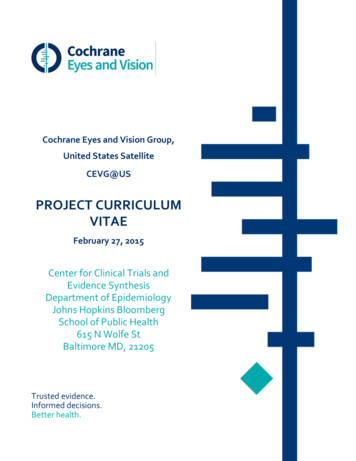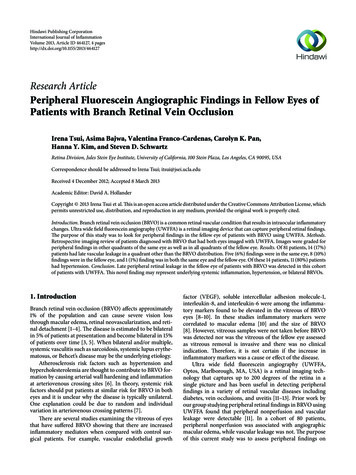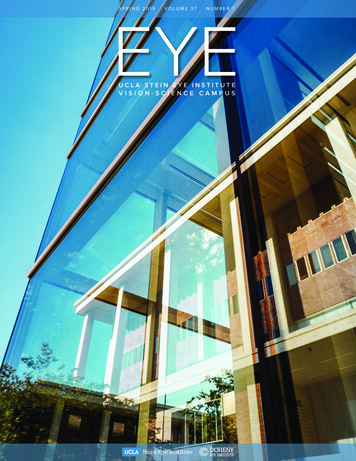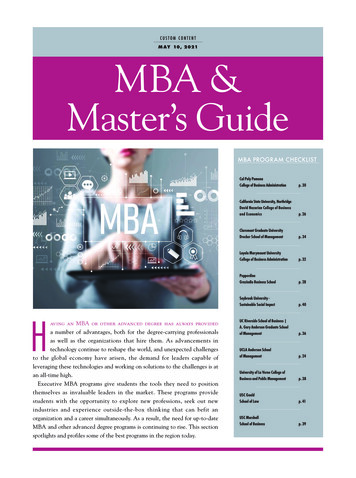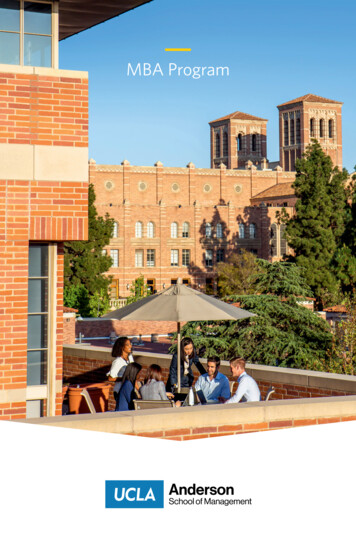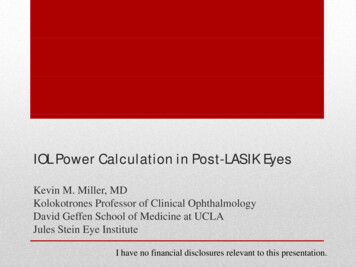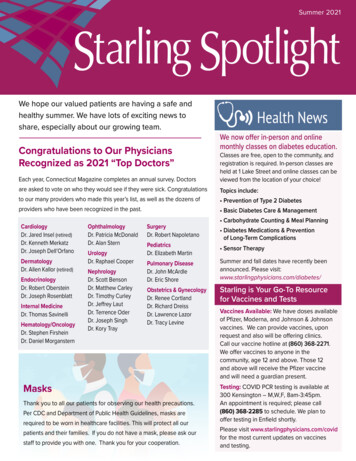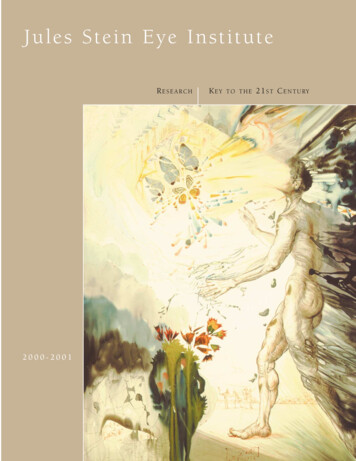
Transcription
Jules Stein Eye InstituteRESEARCH2000-2001KEYTO THE21 S T C E N T U RY
Highlightsof the Year
JU L E SDEPARTMENTOFST E I NOPHTHALMOLOGY/EIY EUCLA SCHOOLOFN S T I T U T EMEDICINEDear Friends,I am pleased to share these highlights of the 2000–2001 academic year, which serve to strengthen the legacy of our commitmentto preserving sight and preventing blindness. This year faculty andtrustees of the Institute received notable honors from eminent organizations, including Research to Prevent Blindness and the Academy of Arts and Sciences. Renewal of major research grants fromthe National Eye Institute and The Foundation Fighting Blindness will enablevision scientists to continue their lifelong work unfolding the mysteries of ophthalmicdiseases and their treatments. We are proud to announce new faculty positionsand new members of the Institute who will collaboratively build upon our achievements in research and patient care. A Vision Genetics Center was inaugurated asthe first step toward integrating genetic research and gene therapy for the molecular treatment of eye diseases. This important investment was made possible by loyalpartners and new friends of the Institute and lays the groundwork for an excitingnew direction in science and medicine.We appreciate your interest in the Institute and our activities, and we share yourbelief that the future is full of promise.Sincerely,Bartly J. Mondino, M.D.Bradley R. Straatsma Professor of OphthalmologyDirector, Jules Stein Eye InstituteChairman, Department of Ophthalmology,UCLA School of Medicine2
Jules Stein Eye InstituteHonorsEach year, as part of their ongoing academic pursuits, faculty members achieve notablerecognition derived from their accomplishments and contributions. They give invitedlectures around the world, they actively participate in prestigious professional and community organizations, and they serve as editors and writers for a wide range of scientific journals. In some cases special honors are bestowed. This year eight facultymembers and three residents and fellows have been recognized for their noteworthyachievements in varied forums. Additionally, three Trustees of the Jules Stein EyeInstitute have been honored for their unique contributions to the city of Los Angeles.V ISION S CIENCE D IVISION H ONORSBasic scientists around the world are laying the foundation for the treatment of humandiseases with genetic therapies. The research currently being conducted by visionscientists holds the promise for those people who, up to now, have had little hope forgood sight in their lifetimes. At the Jules Stein Eye Institute, two vision scientistshave been recognized for their breakthrough contributions to this effort.Debora B. Farber, Ph.D., D.Ph.h.c., Professor of Ophthalmology, earned twodistinguished awards this year for her groundbreaking genetic research into humanretinal degenerations. The Retina Research Foundation selected Dr. Farber as the2000 recipient of the Paul Kayser International Award of Merit in Retina Research.Dr. Farber was also honored with the prestigious UCLA Franklin D. Murphy, M.D.,Prize, awarded for innovative and outstanding academic achievement. Dr. Farber’s laboratory has been instrumental in identifying the genes responsible for various humanretinal degenerations, including some forms of retinitis pigmentosa; and for researching gene therapy techniques that may prevent retinal degenerations in the future.Wayne L. Hubbell, Ph.D., Jules Stein Professor of Ophthalmology, was electedto the prestigious American Academy of Arts and Sciences in April where he joins otherdistinguished members, including Benjamin Franklin, Albert Schweitzer and RalphWaldo Emerson. Dr. Hubbell also received the 2000 Gold Medal from the International EPR (Electron Paramagnetic Resonance) Society. These outstanding awardswere in recognition of Dr.Hubbell’s seminal contributionsto the use of site-directed spinlabeling (SDSL), an innovativemethodology for the explorationof protein structure and dynamics that is currently used in basicscience laboratories worldwide.Drs. Debora Farber andWayne Hubbell are AssociateDirectors of the Jules Stein EyeInstitute and Co-Chiefs ofthe Institute’s Vision ScienceDivision.Dr. Wayne Hubbell3Dr. Debora Farber
Jules Stein Eye InstituteT RUSTEE H ONORSThe Jules Stein Eye Institute’s Trustees bring a wide range of expertise, insight and visionto the programs of the Institute. They have been instrumental in the planning of facilities, the development of philanthropic support, and the recruitment of the world’sbest physicians and scientists. This year, three Trustees have been honored in different venues for their contributions to the city of Los Angeles.At the 18th Annual Upton Sinclair Dinner, Ms. Katrina vanden Heuvel waspresented with the distinguished Founders Award by the Liberty Hill Foundation forher leadership at The Nation magazine, where she serves as editor and provides an eloquent voice for progressive values and politics. The award was one of four honoringdiverse and creative individuals who share a vision of social responsibility in building a Los Angeles that reflects social and racial equality and economic justice.The prestigious Tradition of Caring Award from the Children’s Bureau of Southern California was given to philanthropist Mr. Gerald H. Oppenheimer on behalfof thousands of vision-impaired children. He has generously supported the Children’sBureau for many years with a personal commitment that has changed lives. His longstanding advocacy for the health sciences and for children has won him widespreadpraise and many accolades.The Honorable Wm. Matthew Byrne, Jr., enjoyed a celebration commemoratinghis lifetime of public service to the Los Angeles community. His distinguished careerincludes the job of United States Attorney, heading the second largest federal prosecution office in the country; an appointment to the U.S. District Court; and currently,the position of Chief Judge of the Court. Adding to a career highlighted by civil service, Judge Byrne has served on the Boards of numerous civic and cultural organizations.Mr. Gerald H. OppenheimerL IFETIME A CHIEVEMENT AWARDThe American Academy of Pediatrics bestowed a Lifetime Achievement Award onLeonard Apt, M.D., Professor Emeritus (Active) of Ophthalmology and Founding Chiefof the Division of Pediatric Ophthalmology and Strabismus. The Academy presentsthis award annually to a physician whose contributions to pediatric education andresearch deserve special recognition from the professional community. Dr. Apt’s illustrious career is distinguished by leadership, scientific achievement and medicaladvancement. As the first board-certified physician in both pediatrics and ophthalmology, Dr. Apt helped create the medical subspecialty of pediatric ophthalmology.At UCLA, he established the first full-time division of pediatric ophthalmology at amedical school in the United States, and he is one of the founders of the Jules SteinEye Institute. As clinician, researcher and author, he has made many original contributions in both pediatrics and ophthalmology, including the introduction of newinstruments, products and procedures.4
Jules Stein Eye InstituteR ESEARCHTOP REVENT B LINDNESS (RPB) AWARDSThe Jules Stein Eye Institute is pleased to announce the receipt of prestigious grantsfrom Research to Prevent Blindness (RPB), the world’s leading voluntary organization supporting eye research.Sherwin J. Isenberg, M.D., Grace and Walter Lanz Professor of Pediatric Ophthalmology and Vice-Chairman of the UCLA Department of Ophthalmology, wasselected to receive a Senior Scientific Investigator Award. This notable grant supportsnationally recognized senior scientists conducting eye research at medical institutions in the United States. John R. Heckenlively, M.D., Vernon O. Underwood Family Professor of Ophthalmology, was granted a Physician-Scientist Award, which is anew RPB grant designed to foster the development of outstanding clinical scientists.It is intended to provide greater opportunities for specialized research having directapplication to the human condition. Dr. Heckenlively is one of seven physician-scientists to receive it.The UCLA Department of Ophthalmology was awarded an unrestricted researchgrant under the direction of its chairman, Bartly J. Mondino, M.D. He plans to usethe monies to help support research efforts of junior faculty members, as well as fundinnovative pilot projects.Since its founding in 1960, Research to Prevent Blindness has channeled morethan 172 million to medical institutions for research into the causes, treatment andprevention of blinding eye diseases.L OS A NGELES C OUNTY M EDICAL A SSOCIATION P RESIDENCYAfter serving the Los Angeles County Medical Association through a series of delegate and trustee seats, Clinical Professor of Ophthalmology Kenneth J. Hoffer, M.D.,assumed the presidency for the 2000–2001 term. Known for his ability to set goalsand resolutely pursue them, Dr. Hoffer has successfully streamlined the governanceof the Association so it can respond more quickly and effectively to members’ needs.Dr. Hoffer’s considerable skills are derived from a career of medical and administrative accomplishments. He has advanced his specialty of refractive surgery by devising new techniques and products, including a patented invention and a widely knownformula for lens power calculations, and by his leadership in founding the AmericanIntra-Ocular Implant Society, known now as the American Society of Cataract andRefractive Surgery. He has achieved all this while building a highly successful ophthalmology practice in Santa Monica, California, and serving the Jules Stein Eye Institute as a voluntary faculty member.5Drs. Sherwin Isenberg (top) andJohn Heckenlively are both clinicians andscientists, working in pediatric ophthalmologyand vision genetics, respectively.Professor of Ophthalmology Barry A.Weissman, O.D., Ph.D., received the2000 University of Houston, College ofOptometry Award for DistinguishedResearch on the Cornea and ContactLens. The award was bestowed at theCollege’s 17th Annual Symposium, inHouston, Texas, on December 3, 2000.
Jules Stein Eye InstituteT OP H ONORSFOR THE I NSTITUTEThe Jules Stein Eye Institute itself is annually acknowledged as a center of excellencein national and international forums. For the 11th consecutive year, U.S. News &World Report, in its 2000 survey of “America’s Best Hospitals,” ranked the Instituteamong the top five ophthalmic centers in the country and number one in the West.Additionally, Ophthalmology Times, a magazine by physicians for physicians, in its“Fifth Annual Best Hospitals Survey,” rated the Institute as the best in the West forresearch, patient care, and residency training, and the third best overall program inthe nation.R ESIDENTSANDF ELLOWSWITHH IGH H ONORSFollowing the exemplary standards set by faculty members, resident physicians andfellows annually receive recognition for their clinical and research efforts. This yearKimberly A. Drenser, M.D., Ph.D., was honored with the 2001 Dr. Henry and Lilian Nesburn Award for her vision science paper, which was written in her first yearof ophthalmology residency. The manuscript has been published in Proceedings of theNational Academy of Science. Beginning specialized study in cornea and external-oculardiseases, Tommy S. Korn, M.D., brings with him the prestigious 2001 Heed Fellowship, which is given to graduating ophthalmology residents who demonstrateexcellence in both clinical and research activities. EyeSTAR trainee Stephen H. Tsang,M.D., Ph.D., won a Fight-for-Sight Grant-in-Aid Award from Prevent Blindness America. This support, along with two previous grants, will be directed to Dr. Tsang’sgenetic laboratory research into retinal degeneration.From top areDrs. Kimberly Drenser,Tommy Korn and Stephen Tsang6
Jules Stein Eye InstituteResearchDuring the academic year, faculty members won renewal of five, large research grantsfrom the National Eye Institute (NEI) that will support important, ongoing clinicaland basic science research at the Institute. Additionally, a center grant for vision science from The Foundation Fighting Blindness was renewed. New funding from theU.S. Department of Defense and from Fight-for-Sight, a private agency, will providemonies for established vision science projects. A new NEI grant was awarded for clinical investigations into glaucoma, and clinical trials for age-related macular degeneration and diabetic retinopathy were initiated as a result of new partnerships withpharmaceutical companies.Ben J. Glasgow, M.D., AssociateProfessor of Ophthalmology and ofPathology and Laboratory Medicine, haswon renewal of an NEI grant to continuehis investigation into the role of proteinsin the molecular mechanisms of tearfilm formation.N EW G LAUCOMA R ESEARCHA major NEI grant was awarded to Joseph Caprioli, M.D., Frances and Ray StarkProfessor of Ophthalmology and Chief of the Glaucoma Division, to conduct longrange research into the assessment of optic nerve damage leading to glaucoma.Dr. Caprioli asserts that assessment of the eye’s optic nerve and nerve fiber layer is important to the early detection and timely treatment of glaucoma. In this research, he willattempt to develop new structural measures that are sensitive and specific forearly and progressive glaucomatous optic nerve damage and determine their diagnostic precision. Techniques to be evaluated include highly specialized photographyand laser imaging.C OLLABORATIVE O CULAR M ELANOMA S TUDYThe Jules Stein Eye Institute will continue its participation in the Collaborative Ocular Melanoma Study (COMS), the most comprehensive set of clinicaltrials in the world for investigation into the treatment and outcome of thisrare disease. Renewal of the NEI grant, which is under the direction of RobertE. Engstrom, Jr., M.D., Assistant Professor of Ophthalmology, and BradleyR. Straatsma, M.D., Founding Director of the Jules Stein Eye Institute, willenable the Institute to continue evaluating the effectiveness of treatmentoptions, as well as treatment effects and quality of life for patients withmelanoma of the eye.Bradley Straatsma is Co-Investigatorfor the Jules Stein Eye Institute in anational study of ocular melanoma.7
Jules Stein Eye InstituteA N EW PARADIGMEyeSTAR trainee Stephen Tsang, M.D.,Ph.D., won renewal of a grant-in-aidfrom Fight-for-Sight to support hispostdoctoral research into cyclicGMP phosphodiesterase, an essentialcomponent in retinal functionand survival.FORS TRABISMUS S URGERYMisalignment of the eyes, called strabismus, is prevalent in the United States, particularlyamong children, and is usually treated surgically with modest success. Ongoing laboratory and clinical research into the biomechanical analysis of strabismus surgery,under the direction of Joseph L. Demer, M.D., Ph.D., Laraine and David GerberProfessor of Opthalmology and Professor of Neurology, has won major support fromthe NEI in the form of a five-year grant renewal, bringing total federal funding to15 years. The overall aim of this long-term, multidisciplinary project is to develop arealistic and quantitative understanding of the extraocular muscles and associatedconnective tissues responsible for the movement and alignment of the eyes. Researchto date is very promising, suggesting a new paradigm for the diagnosis and treatmentof strabismus in the near future.M OUSE M ODELSOFR ETINAL D EGENERATIONThe mouse has proven to be a unique and invaluable resource in advancing vision genetics research because the mouse genome is almost identical to the human. Additionally, eye diseases in mice often mimic the same diseases in humans. John R.Heckenlively, M.D., Vernon O. Underwood Family Professor of Ophthalmology, haswon renewal of an NEI grant to continue his work developing mouse models that canbe used in investigations of many forms of retinal degeneration, including retinitis pigmentosa. His contributions to vision science in this regard assist researchers acrossthe country in their work to identify human genes that may cause disease.N EUROPROTECTIONFOR I SCHEMICO PTIC N EUROPATHYNew drug intervention holds promise for a devastating eye disease called ischemic opticneuropathy, which causes sudden loss of vision as a result of circulatory problems withinthe optic nerve. Anthony C. Arnold, M.D., Professor of Ophthalmology and Chief of the Neuro-Ophthalmology Division, hasinitiated clinical trials in partnership with Allergan Pharmaceutical Company that will evaluate the efficacy of brimonidine, a drugcustomarily used in glaucoma treatment. It is hoped that brimonidine will be effective in preventing cell death and blindnessfor patients in the early stages of ischemic optic neuropathy.Dr. Anthony Arnold conducts research andtreatment for ischemic optic neuropathy, adisease of the optic nerve.8
Jules Stein Eye InstituteT HE F OUNDATION F IGHTING B LINDNESS C ENTER G RANTSix faculty members studying retinal degenerations are part of a multi-pronged, privately funded center grant from The Foundation Fighting Blindness, which has wona five-year renewal. Their research collectively contributes to varying aspects of visiongenetics. Dean Bok, Ph.D., Dolly Green Professor of Ophthalmology and Coordinatorof the grant, is conducting several projects to identify mutations that cause cell deathin specific types of retinal degeneration. Debora B. Farber, Ph.D., D.Ph.h.c., Professor of Ophthalmology, and Michael Danciger, Ph.D., Researcher in Ophthalmology, are working together on projects to identify the genes that cause various eyedisorders, including the many forms of retinitis pigmentosa. Relative to multipleinvestigations, John R. Heckenlively, M.D., is obtaining blood samples from patientswith inherited retinal degenerations as part of the Institute’s effort to create a DNA bank.Steven Nusinowitz, Ph.D., Associate Researcher in Ophthalmology, is conductingeletrophysiological studies of retinal function in mice. And Kent W. Small, M.D., Professor of Ophthalmology, is mapping the CORD5 genomic region that may play arole in specific degenerative eye diseases.V ISION S CIENCE T RAINING G RANTDr. Dean Bok is Coordinator of a center grantfrom The Foundation Fighting Blindness thatsupports basic science investigations into themany forms of retinal degeneration.A special, integrated research program at the Institute has been renewed. The VisionScience Training Grant, under the direction of Debora B. Farber, Ph.D., D.Ph.h.c.,Professor of Ophthalmology and Co-Chief of the Vision Science Division, is fundedby the NEI. The program supports the training of predoctoral and postdoctoral fellows, providing them with coordinated and organized exposure to a wide range of basicscience techniques and current knowledge in the vision sciences and ophthalmology.Fellows work in the Institute’s laboratories, under the tutelage of vision science faculty. In addition to learning about the fundamentals of vision research, they pursueindividual interests with clearly designed experiments, present their research at formal and informal seminars, and participate in the publication of scientific papers.Upon completion of their fellowships, trainees usually pursue careers in academiaor industry.Wayne L. Hubbell, Ph.D., Jules SteinProfessor of Ophthalmology, has beenawarded a grant from the U.S. DefenseDepartment for his ongoing researchinto site-directed spin labeling (SDSL),a technique pioneered by Dr. Hubbell’slaboratory. SDSL is an important toolin the investigation of the structure anddynamics of proteins, a critical processin understanding disease processes.Doctoral students Ms. Zoe Verney and Mr. Kun Do Rhee, workingin Dr. Xian-Jie Yang’s laboratory, are funded by the Vision ScienceTraining Grant. They are reviewing a picture of the retina imagedfrom a pathology slide lying under the microscope.9
Jules Stein Eye InstituteN EW T REATMENTS FOR “W ET ” A GE -R ELATEDM ACULAR D EGENERATIONIn partnership with leading pharmaceutical companies, Steven D. Schwartz, M.D.,Assistant Professor of Ophthalmology, initiated new clinical trials for the “wet” orexudative form of age-related macular degeneration (AMD). The goal of both studies is to inhibit the growth of abnormal blood vessels (neovascularization) in the macula. In patients with “wet” AMD, new blood vessels grow indiscriminately and oftenbreak, clouding or even obliterating vision. In one study, Dr. Schwartz is evaluatingthe efficacy of the drug anecortave acetate, manufactured by Alcon Laboratories, Inc.,in inhibiting neovascularization. In the second study, he is evaluating the efficacy ofa drug that inhibits a vascular endothelial growth factor (VEGF), which naturallyoccurs in the body and contributes to the development of abnormal blood vessels.The anti-VEGF drug is manufactured by EyeTech Pharmaceuticals, Inc. Dr. Schwartzcontinues to participate in the Submacular Surgery Trials (SST), a set of National EyeInstitute-sponsored multicenter clinical trials to determine whether surgery is betterthan careful observation in selected patients with “wet” AMD.A N EW D RUGFOR THET REATMENTOFD IABETIC R ETINOPATHYAbnormal blood vessel growth is a major component of diabetic retinopathy, an eyedisease that causes vision loss in many millions of diabetics and is the leading causeof disability among working-age Americans. Kent W. Small, M.D., Professor of Ophthalmology, and colleagues at JSEI are conducting a clinical trial in collaboration withNovartis Pharmaceuticals Corporation that is geared toward patients in more advancedstages of the disease. He is evaluating the drug Sandostatin LAR in a national collaborative study. The drug is intended to inhibit blood vessel growth in the retina ofthe eye through hormonal action. Candidates for the study are patients who haveprogressed beyond the early stages of diabetic retinopathy but have not yet reachedthe point where standard treatments, such as laser therapy, are usually recommended.The study offers a unique opportunity to treat a segment of the patient population wherepreviously, ophthalmologists could only monitor the disease.Dr. Steven Schwartz (seated) is conductingclinical trials for the “wet” form of age-relatedmacular degeneration. He is shown hereviewing a photograph of the back of the eye withDr. Allan Kreiger, Chief of the Retina Division.10
Jules Stein Eye InstituteEducationAcademic education is multifaceted, ranging from teaching medical students, residentsand fellows to leading national conferences. In the course of their educational duties,faculty members mentor, counsel, lecture and demonstrate. They are responsible forhundreds of clinical and scientific publications each year, and entrusted with developing and sharing new approaches to science and medicine that will ultimately resultin improved patient care. This year the Institute has achieved a number of noteworthymilestones, including the appointment of new faculty and new members of the JulesStein Eye Institute. This year’s graduating residents have distinguished themselvesby winning clinical fellowships around the country, and the first JSEI international fellowship was launched. Two annual, academic conferences were combined, further integrating the clinical and scientific education programs of the Institute.Dr. Lynn GordonI NTRODUCING N EW FACULTYIn addition to her duties as Chief of the Section of Ophthalmology at the Department of Veterans Affairs Healthcare Center in West Los Angeles, which she assumedin 1999, faculty member Lynn K. Gordon, M.D., Ph.D., became an Assistant Professorof Ophthalmology in the Comprehensive Ophthalmology Division, effective July 1,2000. Dr. Gordon has had a professional commitment to the UCLA Department ofOphthalmology and the Jules Stein Eye Institute since 1985, first as an ophthalmology resident, then as a clinical fellow in neuro-ophthalmology, and for the last decadeas a faculty member serving the clinical, teaching and research missions of the Institute in a variety of ways.Simon K. Law, M.D., Pharm.D., assumed a new role as Assistant Professor ofOphthalmology in the Glaucoma Division, effective July 1, 2000, with full academicresponsibilities in patient care, teaching and research. His appointment includes aposition as Chief of the Section of Ophthalmology Surgical Services with the Department of Veterans Affairs Healthcare Center in West Los Angeles. Dr. Law has workedwith the teaching program in the UCLA Department of Ophthalmology as a ClinicalInstructor since 1998, while practicing as a community ophthalmologist. Previously,he completed a glaucoma fellowship at the Institute in 1997–98 following his ophthalmology residency at the Medical College of Wisconsin.A C OMBINED V ISION S CIENCE AND C LINICAL R ESEARCH C ONFERENCEResearch and Alumni Day is a long-standing tradition at the Institute, showcasingclinical and vision science research conducted by residents and fellows. The bestresearch findings are acknowledged on Graduation Day. Faculty excellence in teaching is also honored through awards presentations. The Annual Post-ARVO (Association for Research in Vision and Ophthalmology) Conference is a more recent traditionthat highlights basic science research presented at the international ARVO meeting.This prestigious event is attended by vision scientists, worldwide. By combining thesetwo important academic meetings, the Institute has provided a more collaborative forumfor emerging clinical and basic science researchers as they struggle to uncover waysto overcome devastating eye diseases.11Dr. Simon Law
Jules Stein Eye InstituteN EW M EMBERSFrom top areDrs. Nicholas Brecha,Michael Danciger andTerry J. Smith.OF THE I NSTITUTEThe Jules Stein Eye Institute welcomed three new members this year, all distinguishedprofessors in the UCLA School of Medicine, offering varied skills and backgrounds,who will collaborate with ophthalmologists and vision scientists at the Institute.Nicholas C. Brecha, Ph.D., Professor of Neurobiology and Medicine, and Vice Chairof the Department of Neurobiology, has dedicated his research career to the mammalian retina with an emphasis on its cellular and neurochemical organization. Hiswork contributes to an understanding of the pathophysiology of retinal dysfunction.Dr. Brecha has spent two decades and most of his academic career at UCLA. His educational background includes doctoral and postdoctoral training in neurobiologyfrom the State University of New York (SUNY) at Stony Brook and at the MedicalResearch Council in Cambridge, England. Michael Danciger, Ph.D., Researcher inOphthalmology, and Chairman of the Department of Biology at Loyola-MarymountUniversity, Los Angeles, has a longstanding working relationship with the Vision Science Division, having been a visiting scholar and researcher since 1987. He wasappointed to a faculty position in 1995. Dr. Danciger’s vision science research focuseson genetic factors in inherited retinal degenerations. His educational backgroundincludes a doctoral degree in microbiology from the University of Oregon. Terry J.Smith, M.D., Professor of Medicine and Chief of the Division of Molecular Medicineat Harbor–UCLA Medical Center, collaborates with faculty in the Orbital and Ophthalmic Surgery Division. His research focuses on the molecular pathogenesis ofthyroid-associated ophthalmolopathy (TAO), which is a component of Graves’ disease. Dr. Smith has a background in biochemistry and molecular biology, as well astraining and extensive clinical experience in endocrinology and ophthalmology.P RESTIGIOUS , N AMED L ECTURESThe 2001 S. Rodman Irvine Prize forfaculty excellence went to ProfessorEmeritus of Pathology and LaboratoryMedicine Robert Y. Foos, M.D.This year, four faculty members were invited to give prestigious, named lectures intheir fields of expertise.៑ As Visiting Professor at the Wills Eye Institute in Philadelphia, Pennsylvania,Joseph Caprioli, M.D., Frances and Ray Stark Professor of Ophthalmology,gave the Edmund B. Spaeth Oration.៑ Debora B. Farber, Ph.D., D.Ph.h.c., Professor of Ophthalmology, gave theTwelfth Annual H.W. Magoun Lecture at the UCLA Brain Research Institute.៑ The Futterman Lecture was presented by Joseph Horwitz, Ph.D., Professor ofOphthalmology, at the University of Washington, in Seattle, Washington.៑ Sherwin J. Isenberg, M.D., Grace and Walter Lanz Professor of Pediatric Ophthalmology, gave the Kambara Lecture as part of the Kambara DistinguishedVisiting Professorship, at the University of Tennessee, in Memphis, Tennessee.12
Jules Stein Eye InstituteE XCELLENCEINT EACHINGSeveral volunteer faculty members were acknowledged, by peer review, for excellence in teaching. Yaron S. Rabinowitz, M.D., Associate Clinical Professor of Ophthalmology, received a UCLA Department of Ophthalmology Association award forbest presentation on Research and Alumni Day. Richard K. Apt, M.D., and HarveyA. Brown, M.D., both Clinical Professors of Ophthalmology; and Benjamin C. Kwan,M.D., and Jeremy E. Levenson, M.D., Assistant Clinical Professors of Ophthalmology, each received a Senior Honor Award for outstanding service in the Department’steaching programs over the last 25 years.H IGH M ARKSTOG RADUATING R ESIDENTSSix of the Institute’s seven graduating ophthalmology residents have been recruitedto clinical fellowships, including prestigious appointments at The Massachusetts Eyeand Ear Infirmary, Casey Eye Institute, Wilmer Eye Institute, and the University of California at San Francisco and San Diego. Sandy Y. Lee, M.D., has been invited to stayat the Jules Stein Eye Institute in the Retina and Vitreous Fellowship.T HE A NN C. R OSENFIELD I NTERNATIONAL F ELLOWSHIPThe Ann C. Rosenfield Fellowship Fund supports the Division of Orbital and Ophthalmic Plastic Surgery’s International Fellowship Program which invites prom
TOP HONORS FOR THE INSTITUTE The Jules Stein Eye Institute itself is annually acknowledged as a center of excellence in national and international forums. For the 11th consecutive year, U.S. News & World Report, in its 2000 survey of "America's Best Hospitals," ranked the Institute among the top five ophthalmic centers in the country and number one in the West.

